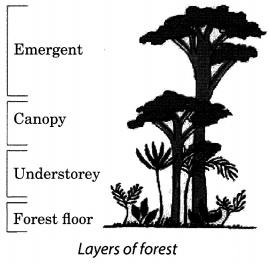On this page, you will find Forests: Our Lifeline Class 7 Notes Science Chapter 17 Pdf free download. CBSE NCERT Class 7 Science Notes Chapter 17 Forests: Our Lifeline will seemingly help them to revise the important concepts in less time.
CBSE Class 7 Science Chapter 17 Notes Forests: Our Lifeline
Forests: Our Lifeline Class 7 Notes Understanding the Lesson
1. A large area of land covered mainly with trees and other plants is called a forest.
2. Forest is a system comprising various plants, animals and microorganisms.
3. The type of animals and kind of trees differ from forest to forest.
4. Forests are the habitat of a large number of different kinds of animals, birds, reptiles, etc.
5. There are four layers of forest named as emergent layer, canopy, understorey and forest floor.
6. In a forest, trees form the uppermost layer, followed by shrubs. The herbs form the lowest layer of vegetation.
7. Based on the life span of plants and trees, they are classified as annuals, biennials and perennials. The organisms which make their own food from carbon dioxide and water in the presence of sunlight and chlorophyll are called producers.
8. The organisms which consume the food made by the producers are called consumers.
9. The organisms which derive their food items from the dead and decaying animals or plants are called decomposers.
10. Plants and animals in a forest depend on each other for many things.
11. In the forest, there is interaction between soil, water, air and living organisms.

12. All plants and animals are linked together by the process of eating and being eaten. This is called a food chain. Many food chains are interlinked to form a food web.
13. Importance of forests are:
- It help in replenishing groundwater.
- It regulate climate, and help rainfall.
- It purify the air and control air pollution.
- It control floods.
14. Forests are also called green lungs because plants release oxygen during photosynthesis which helps in keeping the balance of carbon dioxide and oxygen in the atmosphere.
15. The forest harbours variety of plants, thus providing greater opportunities for food and habitat for the herbivores which in result increases the availability of food for carnivorous animals. That is why, forest is a dynamic living entity.
16. The cutting down of forest trees for personal as well as for commercial purpose is called
17. Deforestation can lead to soil erosion, water pollution, disruption in water cycle, drought, global warming, etc.
18. We must preserve our forest.
Class 7 Science Chapter 17 Notes Important Terms
Canopy: The branches of tall trees of the forest form overhanging covering like a roof over the other plants in a forest. This is called canopy.
Crown: The branchy part of the tree above the stem is known as the crown.
Decomposers: The organisms which derive their food from the dead and decaying animals or plants are called decomposers.
Deforestation: The cutting down of forest for personal or commercial purposes is called deforestation.
Humus: Microorganisms feed upon the dead plants and animal tissues and convert them into a dark coloured substance called humus.
Regeneration: Regeneration is the process of renewal, restoration and growth of new organisms or the existing organisms in an area.
Seed dispersal: The transportation of seeds from the place of their origin to faraway places through various agents is called seed dispersal.
Soil erosion: The phenomenon of washing away of the top fertile layer of soil by water, or wind is called soil erosion.
Understorey: Understorey is an underlying layer of vegetation, specifically, the vegetative layer an especially the trees and shrubs between the forest canopy and the ground cover.